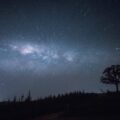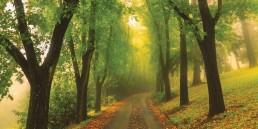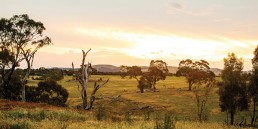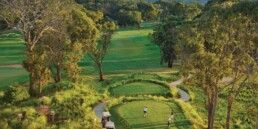Where can you go to see the Milky Way, a summer meteor shower, or view the stars shining as bright as nature intended?
Fortuitously, the answer for Victorians is not very far away and only a short drive from Melbourne – Daylesford and the Macedon Ranges. Glorious celestial views are provided from the area; all you have to do is look up after an insouciant day exploring the earthbound delights on offer in the district.
The heavenly fun begins in early summer on the weekend of 3–5 December when the brightest planets line up in an equidistant straight line, extending diagonally from the horizon in the western sky. You’ll find brilliant Venus closest to the horizon with Saturn higher and Jupiter at the end of the line-up. No special equipment, other than your eyes, will be required to view this stunning and rare phenomenon.
The best view of this enchanting planetary alignment will be from an elevated area, such as the cleared western slope of Mount Macedon, near the car park. I would suggest arriving early before sunset with a picnic rug, a delicious hamper of food from one of the superb regional providores, and a bottle of local wine to match.
But wait, it gets better.
If you can stay in the district over the course of the following week, the moon also enters the sky starting from Monday 6 December and makes the cosmic straight line even longer, by attaching itself to the lower left of Venus. It may be challenging to spot the poetically thin crescent at first, but worth the effort for a seldom seen sight

Now here come the steak knives!
In the ensuing evenings there’s what astronomers call, a series of ‘conjunctions’. For novice stargazers it means the moon will pay a close visit to each of the three planets. On Tuesday 7 December it will be near Venus, on Wednesday it photo-bombs Saturn, and finally on Thursday it hangs with Jupiter.
Early in the New Year, a similar line up is achieved from 4–6 January with Mercury replacing absent Venus, and the crescent moon dances past all three planets over three nights.
A significant milestone in the Earth’s yearly journey around the sun is reached on 22 December – the summer solstice. Coincidently, that evening Mercury joins the other planets to the lower left of Venus, making it four planets in the line to mark the end of this longest day.
The laziest type of observing anyone can partake in is to watch a meteor shower – you can do it in a banana lounge facing the right direction. Unfortunately, nearly all showers are best seen between midnight and dawn. The choice then is to either stay up late, or get up early. The Geminid meteor shower is usually our best for the year in Victoria. It will peak in the predawn hours of 13–15 December. Find a spot away from lights and face the north-east sky. Good viewing may be had from the grassy expanse north of the Lake Daylesford car park looking over the water, or anywhere along the east facing slopes of Mt Franklin. Dress warmly and enjoy up to 50 shooting stars per hour.
Along with these specific events, the clean air around the Macedon Ranges district, especially away from the lights of the city, will reward travellers with superlative views of the Milky Way, stars and constellations through the entirety of the summer months. There’s also the opportunity to view the International Space Station (ISS) and Starlink Satellites under the finest conditions. Go to heavens-above.com enter your location and you’ll get the info of where and when to look to see them.
When you add a ‘G’ to astronomy to create ‘gastronomy’, there’s no better place to savour the excellence of both together, than in Daylesford and the Macedon Ranges.
Photo credit: Janith Hetti Archchige Photos

About the author

Perry Vlahos
Perry Vlahos a noted and dedicated astronomer provides comprehensive, personalized instruction anywhere in Victoria, Australia!
- Perry Vlahoshttps://daylesfordmacedonlife.com.au/author/perry-vlahos/January 13, 2020
Share this article
Come Back to Life
Come and explore our beautiful region, it’s the perfect place to unwind, recharge and rejuvenate. The best bit, we’re only an hour or so from Melbourne.
While You're Here
Autumn
There is no place better than the Daylesford Macedon Region to witness the spectacle of autumn…
High on a Hill a Legend Grows
It is very quiet and still on the craggy hilltop until a biting wind whips the gum leaves from…
Everything You Need to Know for Your First Visit to Hanging Rock
‘Hanging Rock’ technically named Mt Diogenes is pretty damn impressive. Here’s a guide on how to…
School Holiday Family Fun
Don’t let the cooler weather deter you this winter, Daylesford and the Macedon Ranges are splendid…
Curiosity the Antidote to Anxiety
Life is one big unknown. We don’t know what will happen next, so why do we worry about the unknown?…
Fairway to Heaven
When one thinks of Daylesford and the Macedon Ranges, golf isn’t usually the first thing that…









